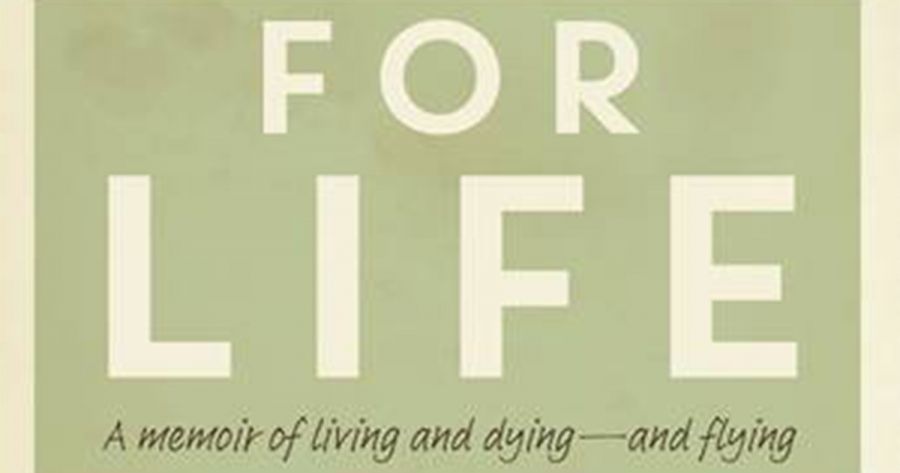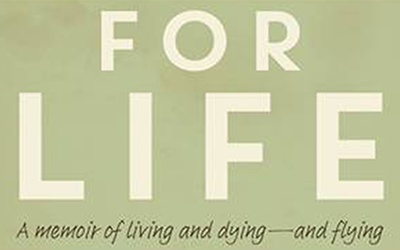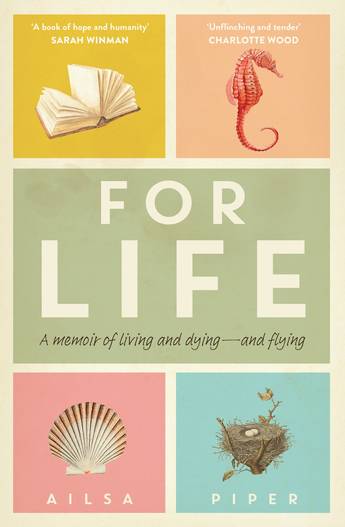
- Free Article: No
- Contents Category: Memoir
- Review Article: Yes
- Article Title: The grey dress
- Article Subtitle: Breaking through to life and change
- Online Only: No
- Custom Highlight Text:
Shortly after the unexpected death of her husband in 2014, Ailsa Piper put on a grey dress which she wore each day for the next six months. Of all the recurring and often exquisite motifs in her memoir, For Life, this prosaic re-worn grey dress speaks most eloquently of the dullness, constraint, and repetition of grief. Late in the memoir, Piper mentions a photograph that her husband took of her on holiday. She is naked in a thicket of tea-trees, and although she is not, at that point, a swimmer, she is wet from the ocean and thrilled. The contrast between the solitary costume of bereavement and this bare delight could not be more marked.
- Featured Image (400px * 250px):

- Alt Tag (Featured Image): Brenda Walker reviews ‘For Life: A memoir of living and dying – and flying’ by Ailsa Piper
- Book 1 Title: For Life
- Book 1 Subtitle: A memoir of living and dying – and flying
- Book 1 Biblio: Allen & Unwin, $34.99 pb, 337 pp
- Book 1 Cover Small (400 x 600):

- Book 1 Cover (800 x 1200):

For Life is bookended by two deaths, that of her husband, Peter Curtin, to whom Piper had been married for twenty-seven years, and the more recent death of her father, an endearing man who lives to a great age while largely consuming cigarettes and cornflakes. Both men are kind, astute: ‘men of few words, who love words’. The losses run deep. Peter’s death challenges Piper’s actual self-perception: ‘I had no idea if there even was a “me” without him.’ The memoir describes her movement from devastation to self-possession through the almost complete transformation of her life – a relocation from Melbourne to Sydney, a passion for ocean swimming and the new social connections that this brings, and the intense and thoughtful observation of the natural world. The act of writing is at the heart of her recovery; she composes her new, single self on the page, and in the process reveals a great deal about the way identity and recovery might function. The title, For Life, points in two directions: towards monogamy, but also towards vitality, regeneration, and a single life.
Piper is a writer, audio book reader, festival interviewer, and the author of a previous memoir, Sinning Across Spain (2017), an account of walking the Camino in the aftermath of her husband’s death, and a co-written book on friendship, The Attachment: Letters from a most unlikely friendship (2017). She was a successful actor, particularly in television. Her husband was a prolific stage, film, and television actor. This public success is not on display in For Life, except when theatre, for example, might illuminate the central issue of loss and the self. We learn a little about Peter – his desire to leave Australia for France, his devotion to words and the dictionary, his breathlessness and low moods – but this is not a biography, and the memoir concerns Piper and Curtin as an intimate couple, and the aftermath of that intimacy.
Piper is constantly reaching for her absent companion, interrupting the narrative with an observation or an aside: ‘Notice that, Pete?’; ‘How appalled you’d have been by that, Pete’; ‘Bend or tend? What a difference a consonant makes, eh Pete?’ At one point she says ‘I seem to be writing you a letter. Can’t help myself.’ In the strange zone of irrationality that often accompanies bereavement, she questions her lost husband: ‘Where might you be? Can you be anything now?’; ‘Where are you, Peter?’; ‘How is it where you are?’ This is desperately sad. But it isn’t static. She learns a good deal from swimming, which she took up after Peter’s death. It steadies her breathing and releases her from gravity and misery. (It is impossible to swim in a grey dress.) We witness the development of her new identity, and the memoir is thoughtful about the limitations of coupledom. There are distortions of the self in such intense reciprocal love: ‘I fell for the Peter who had fallen for me and vice versa.’ In the end, there is acceptance, understanding, and gratitude, and a keen, life-preserving perception that keeps company with grief.
This perception is intensely metaphoric. The memoir opens with a scene of rescue: seahorses are being disentangled from a shark net that has been lifted to the surface of the ocean for repairs. Piper holds one in her hand, assessing whether it is a candidate for relocation to a safer habitat, while hungry gulls watch from above. Seahorses are tiny and fascinating: they mate for life, dance with their partners, and the males incubate eggs. Their curved spines remind Piper of a significant structure of the brain: the hippocampus, which is the repository of memory and therefore the foundation of memoir. The vigour of the seahorse, its aquatic origin, its jeopardy and strangeness, becomes a metaphor for the act of remembering.
Birds, too, have complex metaphoric associations in For Life. Cockatoos are ‘sky-dancing’, or they are ‘sky-swimmers’. Death is ‘the winged thing’, or ‘the feathered predator’. The memoir throngs with birds – falcons, cockatoos, ravens, hawks, wrens, pigeons, magpies, pelicans, a kookaburra, gulls, currawongs, lorikeets, tawny frogmouths, and an osprey. When Piper’s father is dying, she murmurs Emily Dickinson’s ‘Hope is a thing with feathers’ to him. But the most significant birds are her companions during Covid lockdowns – the peregrine falcons at 367 Collins Street in Melbourne, visible on a webcam that displays their annual cycle of nesting and raising their young. Parental faithfulness and care are visible on camera, but Piper also notes the death of the least robust chick, and the sharp drop beside the nest: ‘Do they know they are on the edge of an abyss?’ The most significant avian association is with the act of writing the memoir. Chicks hatch in solitude, following a procedure which they cannot be aware of in advance. At one point, Piper finds herself tapping at her keyboard ‘like a falcon chick pipping at a shell’. Writing is her way of breaking through to life and change, to a new and previously unimaginable self.


Comments powered by CComment